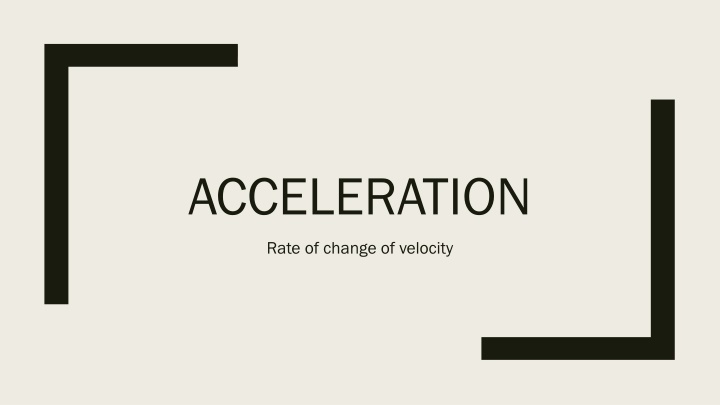
Acceleration in Physics
Learn about acceleration in physics, including its definition, types (positive, negative, uniform, non-uniform), and examples. Discover how acceleration is calculated, its units, and practical applications in motion analysis.
Download Presentation

Please find below an Image/Link to download the presentation.
The content on the website is provided AS IS for your information and personal use only. It may not be sold, licensed, or shared on other websites without obtaining consent from the author. If you encounter any issues during the download, it is possible that the publisher has removed the file from their server.
You are allowed to download the files provided on this website for personal or commercial use, subject to the condition that they are used lawfully. All files are the property of their respective owners.
The content on the website is provided AS IS for your information and personal use only. It may not be sold, licensed, or shared on other websites without obtaining consent from the author.
E N D
Presentation Transcript
ACCELERATION Rate of change of velocity
Defination In non-uniform motion,the velocity of a body changes with time . For example, when a train leaves or approaches the platform its velocity changes with time. The change in velocity of an object with time is given by a physical quantity known as acceleration. Acceleration: acceleration of a body or an object is defined as the rate of change of velocity.i.e. the change in velocity per unit time. Acceleration =change in velocity /time taken. It is denoted by a and it is a vector quantity. Let the initial velocity of an object = u, final velocity of an object = v and time taken by it is t then acceleration = (v acceleration = (v- -u))/t u))/t
Types of acceleration Positive acceleration: If the velocity of an object increases with time in direction of motion of the object , then the acceleration of the body is known as positive acceleration. For ex. A car picks up the speed in a particular direction. It is denoted by a.as v>u. Negative acceleration or retardation: If the velocity of an object decreases with time, then the acceleration of the object is known as acceleration. The direction of negative acceleration is in a direction opposite to the direction of motio.It is written as a. Eg. If an object moving with certain velocity is brought to rest. Acceleration without changing speed: when an object moves in a circular path with constant speed ,then its velocity changes due to change in direction of motion of the object.
Uniform and non uniform acceleration If the velocity of an object changes by an equal amount in equal intervals of time , then the acceleration of the object is said to be uniform acceleration. And such motion is known as uniformly accelerated motion.eg. The motion of the ball rolling down a smooth incline plane. If the velocity of an object changes by an unequal amount in equal interval of time, then the acceleration is said to be non- uniform or variable accele5.eg. The motion of a bus leaving or entering the bus stop. Unit of acceleration: Unit of acceleration: as we know acceleration = change in velocity/time taken acceleration = change in velocity/time taken I.e. acceleration = unit of velocity/unit of time = meter per I.e. acceleration = unit of velocity/unit of time = meter per second square second square. .
Worksheet 1. 2. Define retardation. Give two examples of retardation. A train moves with velocity of 54 km/ h and moves with the same velocity for next 5 sec. What is its acceleration.? Define acceleration. Write its SI unit. A quantity has a value -6 m/s . Name the quantity? A particle is moving with a constant speed then find its acceleration. Write an example where the speed of an object is constant but its motion is accelerated motion. A body moves with velocity 45m/s and acquire velocity 75 m/s in 5 sec. Find the acceleration of the body. Acceleration is a .. Physical quantity as it has the sense of along with magnitude. A bus takes 8 hours to cover a distance of 320km. What is its average speed. 10. An object moves through 10m in 3 min and 40m in next 5min.find its average speed. 3. 4. 5. 6. 7. 8. 9.
